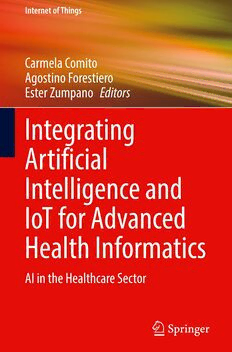Table Of ContentInternet of Things
Carmela Comito
Agostino Forestiero
Ester Zumpano Editors
Integrating
Artificial
Intelligence and
IoT for Advanced
Health Informatics
AI in the Healthcare Sector
Internet of Things
SeriesEditors
GiancarloFortino,Rende(CS),Italy
AntonioLiotta,EdinburghNapierUniversity,SchoolofComputing,Edinburgh,UK
The series Internet of Things - Technologies, Communications and Computing
publishesnewdevelopmentsandadvancesinthevariousareasofthedifferentfacets
oftheInternetofThings.Theintentistocovertechnology(smartdevices,wireless
sensors, systems), communications (networks and protocols) and computing (the-
ory, middleware and applications) of the Internet of Things, as embedded in the
fieldsofengineering,computerscience,lifesciences,aswellasthemethodologies
behind them. The series contains monographs, lecture notes and edited volumes
in the Internet of Things research and development area, spanning the areas of
wireless sensor networks, autonomic networking, network protocol, agent-based
computing,artificialintelligence,selforganizingsystems,multi-sensordatafusion,
smartobjects,andhybridintelligentsystems.
**Indexing:InternetofThingsiscoveredbyScopusandEi-Compendex**
Moreinformationaboutthisseriesathttps://link.springer.com/bookseries/11636
Carmela Comito • Agostino Forestiero
Ester Zumpano
Editors
Integrating Artificial
Intelligence and IoT for
Advanced Health Informatics
AI in the Healthcare Sector
Editors
CarmelaComito AgostinoForestiero
ICAR-CNR ICAR-CNR
UniversityofCalabria UniversityofCalabria
Rende,Italy Rende,Italy
EsterZumpano
DIMES
UniversityofCalabria
Rende,Italy
ISSN2199-1073 ISSN2199-1081 (electronic)
InternetofThings
ISBN978-3-030-91180-5 ISBN978-3-030-91181-2 (eBook)
https://doi.org/10.1007/978-3-030-91181-2
©TheEditor(s)(ifapplicable)andTheAuthor(s),underexclusivelicensetoSpringerNatureSwitzerland
AG2022
Thisworkissubjecttocopyright.AllrightsaresolelyandexclusivelylicensedbythePublisher,whether
thewholeorpartofthematerialisconcerned,specificallytherightsoftranslation,reprinting,reuse
ofillustrations,recitation,broadcasting,reproductiononmicrofilmsorinanyotherphysicalway,and
transmissionorinformationstorageandretrieval,electronicadaptation,computersoftware,orbysimilar
ordissimilarmethodologynowknownorhereafterdeveloped.
Theuseofgeneraldescriptivenames,registerednames,trademarks,servicemarks,etc.inthispublication
doesnotimply,evenintheabsenceofaspecificstatement,thatsuchnamesareexemptfromtherelevant
protectivelawsandregulationsandthereforefreeforgeneraluse.
Thepublisher,theauthorsandtheeditorsaresafetoassumethattheadviceandinformationinthisbook
arebelievedtobetrueandaccurateatthedateofpublication.Neitherthepublishernortheauthorsor
theeditorsgiveawarranty,expressedorimplied,withrespecttothematerialcontainedhereinorforany
errorsoromissionsthatmayhavebeenmade.Thepublisherremainsneutralwithregardtojurisdictional
claimsinpublishedmapsandinstitutionalaffiliations.
ThisSpringerimprintispublishedbytheregisteredcompanySpringerNatureSwitzerlandAG
Theregisteredcompanyaddressis:Gewerbestrasse11,6330Cham,Switzerland
Preface
The integration of Internet of Things (IoT) and artificial intelligence (AI), two
emergingtopicsincomputercommunicationandnetworkingresearch,isbecoming
commonpracticeinmanyinterdisciplinaryareasofapplication,amongwhichsmart
healthcare plays an important role. Efficient collecting, monitoring, controlling,
optimization, modeling, and predicting are the key steps that provide for the
integration of AI algorithms and IoT systems. In the smart healthcare field, in
whichubiquitouscomputingandtraditionalcomputationalmethodsaloneareoften
inadequate, many advantages and improvements arise when exploiting AI within
IoTarchitectures.AIandIoTtechniques,indeed,canplayacrucialroletodealwith
suchamountsofheterogeneous,multi-scale,andmulti-modaldatacomingfromIoT
infrastructures[1].Thedifferentandnumerousissuesinthehealthcareenvironment
requires innovative and advanced methodological, theoretical, and mathematical
modelling and the implementation of protocols and computational methods to be
effectivelyaddressed[2].ThisbookexploreshowthefusionofIoTandAIallows
thedesignofmodels,methodologies,algorithms,evaluationbenchmarks,andtools
thatcanaddresschallengingproblemsrelatedtohealthinformatics,healthcare,and
well-being.
Chapter “Lower-Gait Tracking Application Using Smartphones and Tablets”
extends a previous application, the Lower-Body Motion Tracking version 1.0.1
(LGait), introducing a mobility analysis using smartphones and tablets. The pro-
posed system is designed to support the medical qualifying of mobility in various
settings,andcanbegeneralizedtootherapplications.
Chapter “One-Class Classification Approach in Accelerometer-Based Remote
Monitoring of Physical Activities for Healthcare Applications” proposes an OCC-
basedHARarchitecturewithIoTintegration.InproposedOCCscheme,theauthors
utilize artificial data generation (ADG) to generate training data for the negative
classbasedonthetargetclass.ResultsofanexperimentalstudyforourOCCmodel
onadatasetconsistingofambulatoryandstaticactivitiesarepresented.
Chapter “Detecting and Monitoring Behavioural Patterns in Individuals with
Cognitive Disorders in the Home Environment with Partial Annotations” seeks
to characterize behavioral signatures of mild cognitive impairment (MCI) and
v
vi Preface
Alzheimer’s disease (AD) dementia. The authors introduce bespoke machine
learningtechniquesaccountingforpartialannotationstoproducebehavioralmetrics
ofkeysymptomsandusetheseonanoveldatasetoflongitudinalsensordatafrom
personswithMCIandAD.
Chapter “Toward On-Device Weight Monitoring from Selfie Face Images
Using Smartphones” presents an evaluation of several lightweight CNNs such
asMobileNet-V2,ShuffleNet-V2,andlightCNN-29forBMIpredictionandobesity
classification from facial images captured using smartphones. The comparative
analysisisdonewithheavyweightVGG-16andResNet-50basedCNNmodels.
Chapter “Convergence Between IoT and AI for Smart Health and Predictive
Medicine” exhibits a literature review conducted to determine the most important
technologies, methodologies, algorithms, and models for smart health systems. In
addition,themainbenefitsandchallengesofsmarthealthwereexplored.
Chapter “An Artificial Intelligence and Internet of Things Platform for Health-
careandIndustrialApplications”presentsanartificialintelligence(AI)andInternet
of Things (IOT) based platform. For applications where an AI is needed, e.g.,
face/object/scene detection/classification/recognition, an AI engine is presented,
while for applications where large-scale searching is needed, a search engine is
presented.
Chapter“MethodsinDigitalMentalHealth:Smartphone-BasedAssessmentand
InterventionforStress,Anxiety,andDepression”presentsanearlyattempttocodify
the highly interdisciplinary relationship between technology and mental health.
Indeed,technologies,especiallyartificialintelligenceandInternetofThings,enable
assessmentandinterventiontobetailoredveryspecificallytotheindividual.
Chapter “AI for the Detection of the Diabetic Retinopathy” describes the state
of the art of AI-based DR screening technologies, some of which are already
commerciallyavailable.
Chapter“EnhancingEEG-BasedEmotionRecognitionwithFastOnlineInstance
Transfer”proposesfastonlineinstancetransfer(FOIT)forenhancingtheaffective
brain computer interface (aBCI). FOIT heuristically selects auxiliary data from
historical sessions and (or) other subjects, which are subsequently combined with
thetrainingdataforsupervisedtraining.
Chapter“UsingAssociationRulestomineActionableKnowledgefromInternet
ofMedicalThinksData”investigatesinnovativemethodstoanalyzeefficientlydata
produced by the Internet of Medical Things (IoMT). Association rules (AR) are a
simpleandeffectiveunsupervisedlearningmethodologyusedtoextractactionable
knowledge from these dynamic data, which can be used at the edge of IoMT, or
evendirectlyembeddedintotheIoMtdevices.
References
1. Piccialli,F.,DiSomma,V.,Giampaolo,F.,Cuomo,S.,Fortino,G.:Asurveyon
deeplearninginmedicine:Why,howandwhen?Inf.Fusion66,111–137(2021)
Preface vii
2. Khan, S.R., Sikandar, M., Almogren, A., Din, I.U., Guerrieri, A., Fortino, G.:
IoMT-based computational approach for detecting brain tumor. Future Gener.
Comput.Syst.109,360–367(2020)
Rende,Italy CarmelaComito
Rende,Italy AgostinoForestiero
Rende,Italy EsterZumpano
Contents
Lower-GaitTrackingApplicationUsingSmartphonesandTablets........ 1
TruongX.Tran,Chang-kwonKang,andShannonL.Mathis
One-Class Classification Approach in Accelerometer-Based
RemoteMonitoringofPhysicalActivitiesforHealthcareApplications.... 9
GamzeUslu,BerkUnal,AylinAydın,andSebnemBaydere
DetectingandMonitoringBehaviouralPatternsinIndividuals
withCognitiveDisordersintheHomeEnvironmentwithPartial
Annotations....................................................................... 25
WeisongYang,RafaelPoyiadzi,YoavBen-Shlomo,IanCraddock,Liz
Coulthard,RaulSantos-Rodriguez,JamesSelwood,andNiallTwomey
TowardOn-DeviceWeightMonitoringfromSelfieFaceImages
UsingSmartphones .............................................................. 53
HeraSiddiqui,AjitaRattani,LailaCure,NikkiKeeneWoods,Rhonda
Lewis,JanetTwomey,BettySmith-Campbell,andTwylaHill
Convergence Between IoT and AI for Smart Health and
PredictiveMedicine.............................................................. 69
CarmelaComito,DeborahFalcone,andAgostinoForestiero
AnArtificialIntelligenceandInternetofThingsPlatformfor
HealthcareandIndustrialApplications ....................................... 85
WeijunTan,YueZhuo,XingChen,QiYao,andJingfengLiu
Methods in Digital Mental Health: Smartphone-Based
AssessmentandInterventionforStress,Anxiety,andDepression ......... 105
TineKolenik
AIfortheDetectionoftheDiabeticRetinopathy............................. 129
EugenioVocaturoandEsterZumpano
ix
x Contents
EnhancingEEG-BasedEmotionRecognitionwithFastOnline
InstanceTransfer................................................................. 141
HaoChen,HuiguangHe,TingCai,andJinpengLi
UsingAssociationRulestoMineActionableKnowledgefrom
InternetofMedicalThinksData ............................................... 161
GiuseppeAgapito
Index............................................................................... 171

